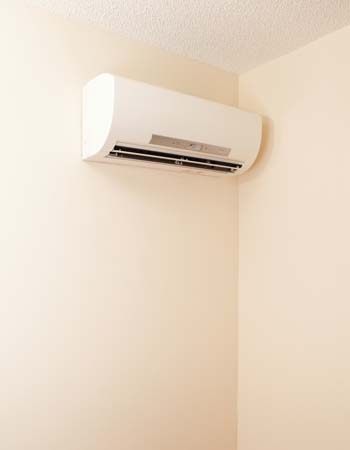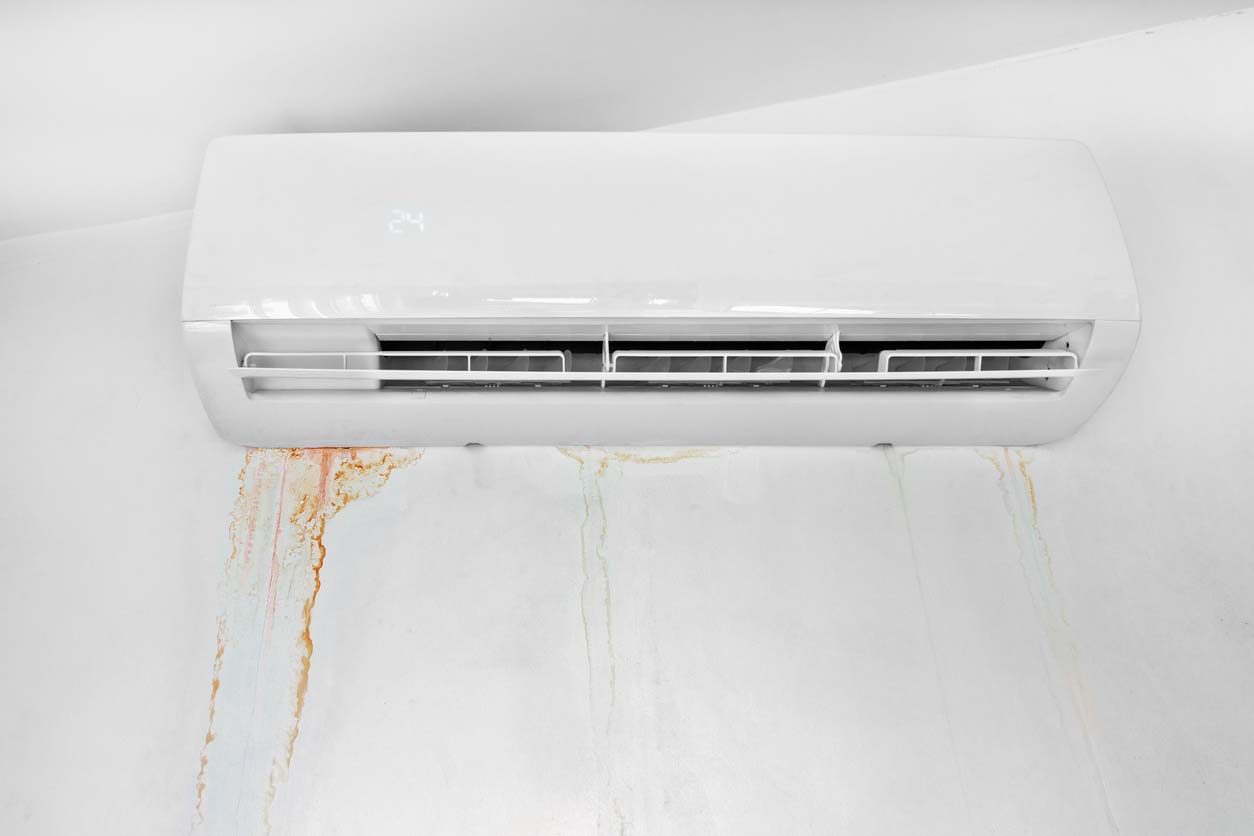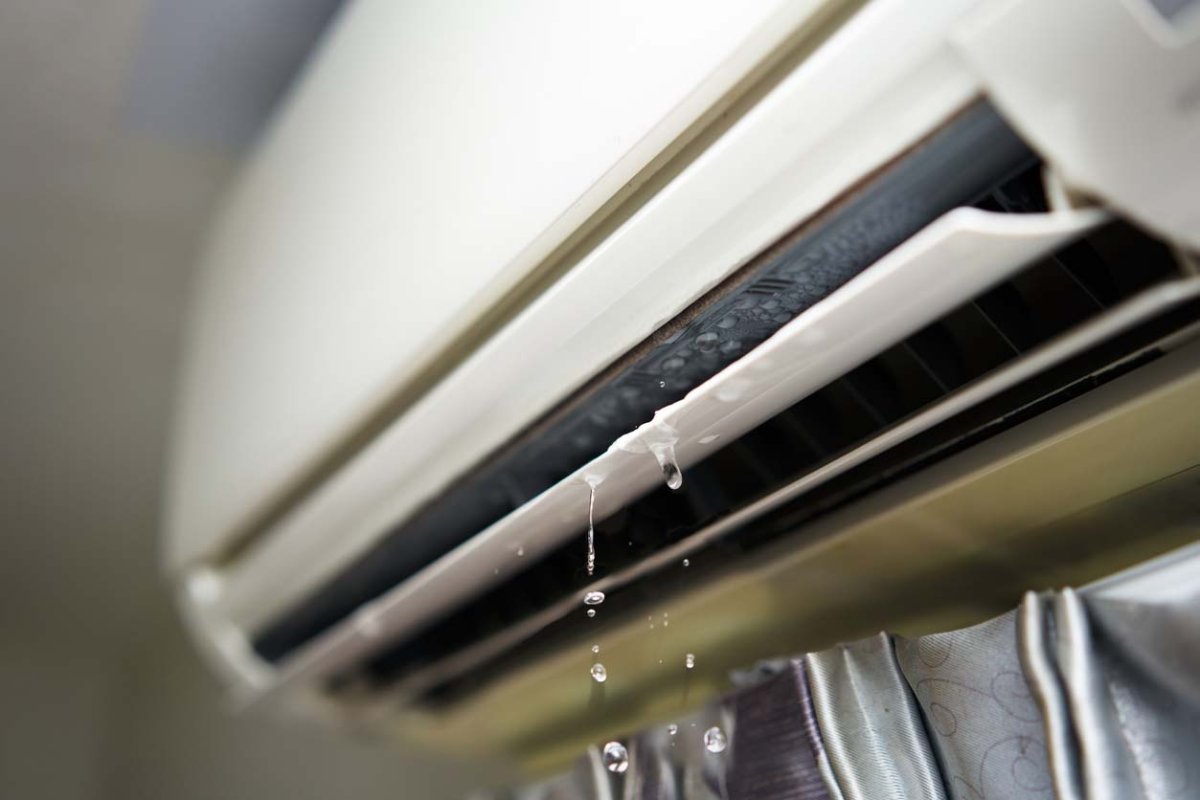We may earn revenue from the products available on this page and participate in affiliate programs. Learn More ›
Q: My mini-split air conditioning unit usually works great, but the other day I noticed water dripping down the wall underneath it. Why is my mini-split leaking water? Is this something that I can fix on my own, or will I need to call in a professional?
A: It’s frustrating to suddenly find water leaking from a mini-split air conditioning unit. Not only can this issue lead to water damage on the surrounding walls and floors, but it also suggests that the unit is not functioning efficiently. There are a number of explanations for a mini-split dripping water, including a damaged drain line, a malfunctioning pump, or even a refrigerant leak.
Attempting to fix a split-unit AC leaking water could potentially worsen the situation or cause even more damage. Homeowners who are comfortable with basic maintenance can attempt some troubleshooting, but if the problem persists or seems complex, it’s recommended to enlist the expertise of one of the best HVAC companies.
How Ductless Mini-Split Systems Work

In order to determine why a mini-split system is leaking, it’s important to understand the major parts that make up the unit. A ductless AC mini-split system comprises two principal components: the indoor unit and the outdoor compressor or condenser.
The indoor unit takes in warm air from a room and converts it to cool air by running it over a series of evaporator coils filled with refrigerant. The cooled air is then pushed back out to be circulated throughout the room. The indoor component is typically suspended from the ceiling or affixed to a wall so that it can channel the cooled air directly into the living space.
The indoor unit connects to the outdoor condenser through a refrigerant line, a power cable, drain lines, and suction tubing. The refrigerant that has been warmed by the air indoors is transferred to the outdoor condenser to be cooled again. Condensers have varying capacities in terms of the number of indoor units they can accommodate. Multiple indoor units (usually between four and eight) can often be linked together to a single outdoor unit.
When a mini-split system cools the air, any excess moisture turns into condensation inside the unit. Most mini-splits have a drain line or pump that removes this excess water and directs it outside. In this way, the system doubles as a dehumidifier, which can help improve indoor air quality and ward off mold growth. Mini-splits can be more efficient than traditional HVACs because of energy loss associated with ductwork, which can contribute to over 30 percent of air conditioning energy consumption. Each indoor unit also has its own thermostat, which enables selective climate control for each space, saving energy and money.
Ductless mini-split systems can leak water for a number of reasons, but a blocked drain line is one of the most common ones.
One of the disadvantages of mini-split systems is that they can encounter water leakage issues. The most common reason for a leak is if the drain line for a mini-split system is blocked. Mini-splits include a drainage system to manage the moisture that’s extracted from the air during the cooling process. Mini-split condensation can contain small amounts of dirt, debris, or even mold. These can build up over time, resulting in a blockage in the drain line. As the blockage worsens, it becomes difficult for the system to channel the condensed water out of the indoor unit, resulting in the AC indoor unit dripping water. An AC drain clog can be fixed by removing the drain line, inspecting it for obstructions, and gently getting rid of any debris. Since it’s important to not damage the delicate components of the system, many homeowners opt to call in an HVAC technician to stop the mini-split from leaking water inside a home. Whether troubleshooting with a DIY approach or entrusting the task to a skilled professional, it’s essential for homeowners to address a blocked drain line as quickly as possible to keep the mini-split system in good working order.
Drain pans collect water inside the mini-split, so if the drain pan is damaged this can lead to water leaking from the unit.
A mini-split drain pan plays an important role in managing the condensation that accumulates inside the system as warm, humid air encounters the cooling coils. Any water at the bottom of the unit collects in the drain pan, where it is directed to the drain line. Over time, wear and tear or corrosion from rust can weaken the drain pan, and as a result, any water collected may leak from the unit. If the drain pan is damaged, a professional will be able to order a new one and make sure it is installed correctly. To prevent the drain pan from future wear and tear, it’s a good idea to have it cleaned occasionally as part of regular maintenance.
Dirty filters can cause condensation buildup on the unit’s coils, which often leads to water leaks.
Filters serve as the first line of defense against airborne particles and contaminants that could compromise indoor air quality. Over time, these filters can become clogged with dust, pet hair, debris, and other pollutants. As air struggles to pass through, the system’s airflow is impeded, leading to decreased efficiency. The reduced airflow hampers the mini-split’s ability to regulate temperature effectively, causing the coils to become colder than usual. When humid air hits the frigid coils, moisture begins to form. The resulting condensation buildup can eventually overflow, leading to water leaks. If the unit is tilted too far forward, homeowners may even notice the air conditioner spitting water when it’s blowing out cool air.
Regular filter maintenance, such as cleaning or replacing filters according to the manufacturer’s recommendations, can greatly mitigate the risks associated with condensation buildup. By ensuring unobstructed airflow, clean filters help maintain a proper balance between the temperature of the coils and the surrounding air. This not only prevents excessive condensation but also optimizes the system’s performance, potentially extending its lifespan.
Leaking from condensation can also occur if the unit is running low on refrigerant.
Refrigerant facilitates the heat exchange process that’s essential for cooling. As the refrigerant cycles through the system, it alternates between absorbing and releasing heat, resulting in cooler air. Inadequate refrigerant levels can lead to a situation where the mini-split unit’s coils don’t reach the desired temperature during the cooling cycle. As a result, when moisture-laden air comes into contact with the coils, condensation forms, and the unit struggles to handle the excess moisture. This can lead to the mini-split dripping inside, followed by external leaks.
An AC recharge may be needed to remedy this issue. This process involves removing the refrigerant, inspecting the unit for leaks, and replacing the refrigerant. Avoiding a needed AC recharge can damage the compressor or result in a complete breakdown of the unit. Home AC recharge costs run from $200 to $500—a cost that is worth it to many homeowners to keep their AC unit working properly.

It’s possible that the unit is actually leaking refrigerant and not water. Refrigerants pose a serious health hazard, so it’s important that this problem be addressed by a professional immediately.
It’s important to consider that the leakage from a mini-split unit might not always be water—it could be refrigerant. The potential health hazards associated with refrigerants underscore the critical importance of promptly involving a trained professional to address the matter. According to the Environmental Protection Agency (EPA), many refrigerants used in AC units are both flammable and highly toxic, so it’s imperative to treat refrigerant leaks with caution. Hiring a certified professional who has the expertise to identify and address refrigerant leaks is crucial. Professionals know not only how to repair the leak but also how to safely manage the refrigerant and minimize its release into the atmosphere.
If it’s still unclear why the mini-split unit is leaking water, an HVAC technician will be able to identify the issue. It’s generally best to leave repairs to a professional to ensure that the problem is addressed safely and efficiently.
A small water leak might not always escalate to an immediate emergency unless the AC is spraying water or gushing. However, it’s important not to underestimate the potential consequences. Ignoring a minor leak could lead to more significant issues over time, such as water damage, mold growth, or electrical issues, so it’s advisable to stop using the AC unit until the leak is fixed. When the cause behind a mini-split leaking water is unclear, it’s worth having an HVAC technician perform an inspection to identify the issue. HVAC inspection costs between $250 and $400.
While mini-splits are generally less complex than central HVAC systems, repairs are still best handled by HVAC technicians. If a homeowner damages the unit while attempting to fix the problem themselves, the resulting repair costs could be even higher than they would have been for the original issue. It’s also worth noting that any DIY repair work could void the system’s warranty if it has one. Professionals know how to fix a leaking mini-split safely and without causing further damage to the unit. AC repair cost ranges from $100 to $610, with many homeowners spending around $369. Costs may be higher if there is a problem with the outdoor unit as the average cost to replace an AC condenser is about $2,100. In the event the unit is beyond repair and needs to be replaced, homeowners can expect to pay between $2,000 and $14,500 in new mini-split installation costs.
Scheduling regular maintenance can help prevent future leaks and prolong the life of the mini-split system.
Mini-split systems typically require less maintenance compared to traditional HVAC systems since the absence of ductwork eliminates the need for duct cleaning and repair. Newer mini-split systems often come with self-cleaning features and advanced technologies that contribute to lower maintenance requirements. However, regular upkeep is still important to ensure optimal performance, energy efficiency, and the prevention of leaks. Maintenance can include cleaning, replacing filters, inspecting and cleaning coils, checking refrigerant levels, ensuring proper drainage, and verifying the overall functionality of the system. It’s worth noting that as with any electrical or HVAC equipment, damaged components or neglected maintenance could potentially increase the risk of a fire hazard. HVAC service costs can range from $75 to $200, on average.
The frequency of maintenance for a mini-split system can vary depending on factors such as usage, environmental conditions, and the manufacturer’s recommendations. Generally, it’s advisable to schedule maintenance at least once a year, ideally before the outside temperature warms. If the mini-split system experiences heavy usage or is located in an area with higher levels of dust and pollutants, more frequent maintenance might be needed.


